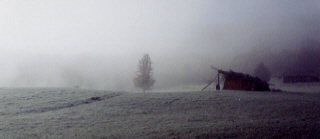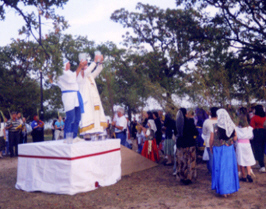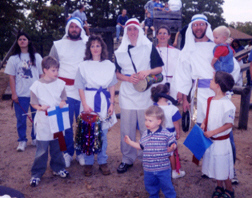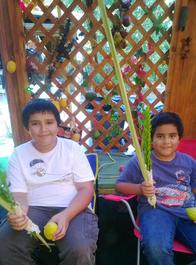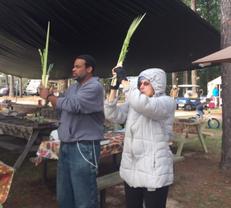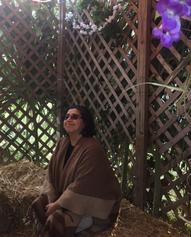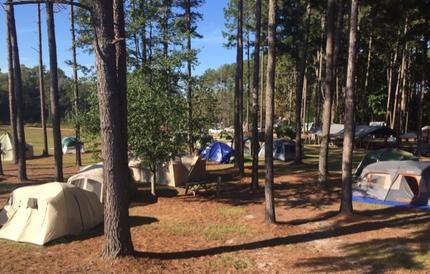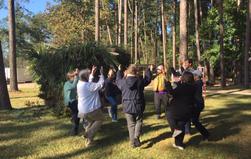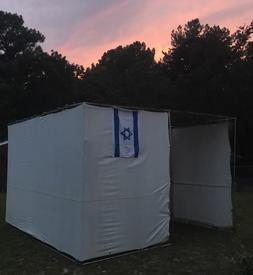Sukkoth
The Feast of Temporary Dwellings
The feast of Sukkoth ("sue-COAT") lasts seven days--from the 15th until the 21st days of the seventh Hebrew month. Sukkoth is plural for sukkah ("SUE-ka"), which is often translated "booth", "hut", or "tabernacle" in the sense of a tent; i.e., it can refer to any kind of temporary structure--one that does not completely keep the weather out. It is even paralleled with a "hiding place" in Psalm 18:11; 31:20, and Job 38:40.
But YHWH knew the participants would not want to stop after seven days, so there is another day tacked on, the 22nd of the month. It is the "eighth" day of the seven-day feast, and is called Shmini Atzereth ("SHMEE-nee ah-TSAIR-et"). Shmini means "eighth". (It is actually also the eighth festival of the year as well.) Atzereth covers the range of meaning from "conclusion", "encore", "affectionate farewell", "enclosure" to "detaining" or "extension". So it is not officially part of Sukkoth, but functions as a continuation of it. It is described by some as an expression of the fact that YHWH, our host, has enjoyed His guests so much that He wants them to stay another day. It is a picture of the way the world will be after the Kingdom has made everything complete, when YHWH can finally be fully at home on the earth.
This last day is the day on which Yeshua called out loudly in the temple that if anyone was thirsty for living water (a symbol of the Torah as interpreted and applied through the spirit, not just the letter), they should come to him and drink. (Yochanan/John 7).
There are more commands in regard to Sukkoth than for most festivals:
"On the first day there shall be a holy gathering: you shall do no servile labor. Seven days you shall bring an offering made by fire to YHWH; on the eighth day, you shall have a holy rehearsal, and you shall burn the fire offering unto YHWH… Take for yourselves on the first day, the fruit of majestic [or ornamental] trees, [date] palm branches (lulavim), and boughs of trees with interwoven foliage, and willows of the brook, and shall rejoice before YHWH your Elohim for seven days… You shall live in temporary dwellings for seven days; all who are home-born in Israel." (Lev. 23:34-43)
Seventy bulls are to be offered at the Temple throughout the seven days: thirteen the first day, twelve the second, and so on down to seven on the seventh day. (Num. 29:12-38)
This feast comes "…after you have gathered in your grain and your wine, and you must rejoice…because YHWH will bless you in all your produce and in all the undertakings of your hands." (Deut. 16:13-15) Everyone in the household, including the servants, is to participate and have the time off from work. The ceasing of work is mandatory on the first day and the eighth. The intermediate days, as at the Feast of Unleavened Bread, are called "ordinary days of the festival" when essential work may be done as needed.
The release of slaves at the end of six years takes place during this festival (Deut. 31:10) as the sabbatical (shmittah) year begins, and the sabbatical year ends at Sukkoth the following year. The second tithe is used to provide for this festival so that everyone can live lavishly during this time, no matter how poor they are the rest of the year. And YHWH even says this is one occasion when we can drink all the strong drink we want. (Deut. 14:26)
Some other names for Sukkoth are Hag haAsif ("the Festival of Ingathering", i.e., harvest), Z'man Simkhateynu ("Season of our Rejoicing"), and Hag haMayim ("Festival of Water"), both because of a special ceremony that will be discussed below and since rainy season is expected to begin soon after it is over. Some time during the festival is devoted to praying for the much-needed rain, as it is said that YHWH decides at this time what the allotment of rain will be for each land in the coming year. Also, if there is ever a mention in Scripture of "the feast" without identifying which one it is, it refers to Sukkoth.
Themes:
Reminder of our ancestors' time in the wilderness (Lev. 23:43). It reminds us not to depend on our secure houses for protection, since YHWH is our real protector.
Foretaste of the Kingdom ("Messianic End of Days"): Sukkoth is one rehearsal for the day when the real pilgrimages will again be possible. It is traditional to read the book of Qoheleth, as depressing as it seems, as a reminder that the Kingdom will be worlds apart from the "vanity of vanities" that we now experience.
Firstfruits of all crops except barley and wheat are brought to the Temple at this time. (Lev. 23:39)
All nations: During the Kingdom, when every nation on earth will be required to send a delegation up to Jerusalem for the Feast of Sukkoth. Those who don't come won't get rain. (Zechariah 14:16-19) 70 bulls are offered, representing the fact that all nations (70 are listed in Genesis 10) will be ruled by the Messiah.
Joy and rejoicing (Deut. 16:14; compare "Behold, I bring you news of great joy to all the peoples." Luke 2:10)
The actual time of Messiah's birth: in contrast to the false celebration in December, Sukkoth is just after the harvest, when shepherds still would have their sheep out in the fields. It is the last of the three pilgrimage festivals required of all able-bodied men, so Joseph would combine the trip to Bethlehem for the census with the also-mandatory journey to the Temple. Not everyone could lodge in Jerusalem at such a crowded time, so many would spill over into the surrounding towns. This explains why there was no room in the inn at Bethlehem, less than five miles away. (The census mentioned in the New Testament was not taken all at once.) Jacob built stables for his animals when he re-entered the promised land. (Genesis 33) The Hebrew word translated "stables" here is none other than sukkoth! In fact, where it says, "The Word was fleshed out and dwelt among us", the last phrase actually means he "lived in a temporary dwelling"--like a tent, or a sukkah! How fitting! And this festival has an eighth day, which would be when he was circumcised.
Hospitality: Guests are invited into one's sukkah to eat together. Seven very honored guests called ushpizin (Abraham, Isaac, Jacob, Joseph, Moses, Aaron, and David) are symbolically invited into the sukkah. (Some include their wives as well.)
Jewish Traditions:
In the Diaspora (dispersion), a ninth day called Simkhat Torah ("Rejoicing in the Instruction") was added, while in the Land of Israel, it is celebrated concurrently with Shmini Atzereth on the eighth day. For those on a yearly or triennial Torah-reading cycle, the last, then first portions of the Torah are read on this day.
Each evening there was a ceremony called Simkhat Beyt haSho'evah ("Rejoicing in the place of the water-drawing") in which water was drawn from the Pool of Shiloakh (Siloam). Even the melody of the lively song U-sha'avtem Mayim (taken from Isaiah 12:3) is thought to date all the way back to this time. After sunset there was great celebration in the Court of Women including special dances by the sages; some even juggled lighted torches! The four great lights that stood in that courtyard lit up the whole city of Jerusalem except the Qidron Valley, and for that reason it was called "the Valley of the Shadow of Death". The huge oil lamps used the worn-out undergarments and belts belonging to the priests as wicks. Young priests-in-training were the ones who carried the oil up the poles to the lamps. The next day there was another ceremony called Nisukh haMayim ("water-pouring") in which that water as well as wine were poured into two different holes in the altar and flowed through special conduits back down into the Qidron Valley.
For the last day of the Feast while the Temple stood, willow branches were cut from Motzah, just west of Jerusalem, and brought to the Temple, where the people circled the altar carrying the willow branches, which made a swishing sound like the wind, and then with them built a sukkah right over top of the altar!
The traditional form of the "taking" of the arba minim (four species mentioned in Lev. 23) is to bind the three green parts (willow branches, palm frond, and myrtle branches) together with a specially-designed wicker holder, and hold the yellow etrog fruit up against it, shaking them together in the four cardinal directions as well as toward the heavens and toward the earth, and saying the blessing, "For the sake of the unification of the Name, Yod-heh with vav-heh…" This is, in part, to acknowledge YHWH's presence everywhere and to draw Him to ourselves as we gather in the resources needed for winter.
A sukkah may be of any size, but traditionally must have at least three sides. Some obtain a prefabricated sukkah, while others build them from scratch. But the roof in particular needs to be made of natural plant material--often more palm branches. By tradition, one must be able to see three stars through openings in the roof (though the whole roof may be waterproofed such as with a tarpaulin if it should rain early). This bears some correlation to the "star" that announced Y'shua's birth at this time.
The sukkah is often decorated with real or artificial fruits and vegetables to represent the plentiful harvest YHWH has brought.
German Jews had a tradition of holding a bonfire to burn the materials the sukkah was made of after the holiday is over.
Additional traditions:
We try to spend the entire feast together rather than going back and forth to our homes, in order to recall the fact that pilgrims would stay in Jerusalem for the whole time when the Temple stood.
We often go camping and have a common meal area and a sukkah in addition to our tents. The sukkah is modular enough to be expanded from year to year as needed. We set up the communal areas first, then personal tents, but we all pitch in and help others set up their tents as well. Everyone has a job assigned, and we all take turns cooking and cleaning up after meals. We only have two full meals per day, plus a snack between them, because we found we were eating or preparing food nearly all the time otherwise!
Throughout the week there are numerous Scriptural teachings, especially about what went on in the Temple during Sukkoth in ancient times and its significance.
We start some of the days with a shakharit (dawn prayer) liturgy.
Campfire when it is cold enough, with kosher marshmallows!
The children decorate the sukkah with items they have made and with pictures that remind us of what went on in Jerusalem at Sukkoth when the Temple stood.
Sleep in the sukkah some nights. At other times we encircle the sukkah seven times, to recall the encircling of the altar in Temple times.
Out from “Under the Sun”
For a long time it mystified me that one of the traditional readings for the feast of Sukkoth was Qoheleth (Ecclesiastes). It is King Solomon’s own account of how he tasted the whole smorgasbord of human experiences and despaired of finding anything of lasting value. “All is vanity” was his analysis. “Everything under the sun is utterly pointless!” A closed cycle of the meaningless repetition of birth, difficult work, and death. It gets nowhere. It’s nothing but maintenance in a world that in the end will not even remember that we were ever here.
In a festival when we are supposed to rejoice (Lev. 23:40), why would we read such a treatise that brings depression and even despair?
When I heard the late British Chief Rabbi Jonathan Sacks’ explanation, it made perfect sense.
All is vanity--unless we are dropped a line from outside the closed system, that is. And by use of that phrase “under the sun”, he hinted that this was indeed a live hope. “Under the sun, all IS vanity.” But YHWH has broken into our closed-cycle history from somewhere that is NOT under the sun.
Genesis showed that because of humanity’s failure, the whole creation has fallen into corruption. Later Paul explained that the entire world is in “bondage to decay because YHWH has subjected it to futility”. (Romans 8:20) But creation was subjected in HOPE. And only as we were given limits could that hope rise to the surface.
Why? Because without limits, we got Babel. Once all nations were scattered and no longer able to unite in a useless goal, the stage was set for the solution. With Abraham, a counter-history began that could go beyond post-Fall norms. He was called a Hebrew--“one who crosses over from the other side”. Israel’s very inception was beyond anything that could come in the course of nature. Its patriarchs were given new names, and all contingencies were severed. A nation was forged in a wilderness that belonged to no other, and history was given a direction. YHWH gave us parameters that made life on a level higher than subservience to our natural inclinations possible.
With this, we are no longer under obligation to the things—within or from outside--that once drove us. The exodus is a live option. The “out” has been granted--even from death. Messiah is the “firstfruits of them who were asleep”. (1 Cor. 15:20) This is the only way out of the endless cycle of futility. So the way Abraham started and Messiah finished opening up is the only history with any real direction or progress.
The Messiah began to reverse the curse, but “we do not yet see all things subjected to him” (Heb. 2:8), for this age only gets a few glimpses of what is to come. But liberation from bondage to the elements was never an option at all before Yeshua neutralized the claims of usurping spirits and the vicious cycles of nature. He restored man to ascendancy, and now YHWH is calling out from “every tribe and tongue” in the world a wildly-different people, an entirely new entity. This community, known as the “called-out ones”, will merge into that counter-history, Israel.
“The true light is already shining.” (1 Yochanan 2:8) In the midst of this chaotic world, we can even now taste the “powers of the age to come”. (Heb. 6:5) The authority that will one day fully triumph can begin to affect our lives right away, changing us from within, with the implantation of a “new heart” and a “new spirit”. (Ezek. 11:19) We are the preview—the evidence that the world will not always be in the hands of those who mismanage it.
Sukkoth is therefore called “the season of our joy”. We are even ordered to be “nothing but joyful” (Deut. 16:15).
And why not? It is when Messiah broke into the vanity the first time, accompanied by “good news of great joy for all peoples” from heavenly messengers (Luke 2:10), and also a picture of the Kingdom that will break into history again when he returns after all have been given this great news. Then, all nations will celebrate Sukkoth. (Zech. 14:16-17) So “Joy to the World!”, a song that is more about his second coming than his first, is thoroughly appropriate for this, the true “season” when the victory over vanity began: “No more let sin and sorrow grow, or thorns infest the ground; he comes to make his blessings flow far as the curse is found!”
Yes, the whole creation will one day be set free from its bondage to decay. (Rom. 8:21) So “be steadfast, unmoved, always abounding in the work of YHWH” because in Him, “your labor is NOT in vain.” (1 Cor. 15:58)
Joy to the World!
Joy to the world! The Lord is come!
Let earth receive her king!
We usually hear that very familiar song at Christmastime. But if you look at the whole song carefully, except for that archaic phrase “is come” (which meant “has come” when English was closer to its German roots), it is not really about the historical time Yeshua came on the scene:
Joy to the earth, the savior reigns…
No more let sin and sorrows grow,
or thorns infest the ground.
He comes to make his blessings known
far as the curse is found.
This does not describe his first coming, but his second, when he indeed reigns and there will actually be changes not just to human lives in a still-corrupt environment, but the very habits of “nature” itself: “The wolf and lamb will feed together, and the lion will eat straw like the ox... They will not hurt nor destroy in all My holy mountain.” (Isa. 65:25) The curse will be greatly mitigated—not totally gone; the part left out in the ellipsis above says the serpent will still eat dust. There will still be death, but with the norm that “from then on there will no longer be an infant [who lives only a few] days or an old man who has not filled his days; for the youngest shall die at 100 years old”. (65:20) The one who possessed or inspired the first dust-eating serpent will be bound. (Rev. 20:2)
Sukkoth, the last of the commanded annual festivals, is a foreshadowing of this world’s final age—the Kingdom.
So it is not really a Christmas song at all. But it works very well for Sukkoth, for more reasons than one.
For starters, Sukkoth is nicknamed the “season of our joy”. We are commanded to “be only joyful”. (Deut. 16:15) In regard to the time described above, YHWH says, “I will rejoice in Jerusalem, and joy in My people; and the voice of weeping shall be no more heard in her, nor the voice of crying.” (Isa. 65:19) Ezra told the returnees from the exile who were being reintroduced to Sukkoth not to weep on this kind of holy day. (Neh. 8:9-11; cf. 8:14) Ecclesiastes (Qoheleth) is read during this festival to remind us that in that future day we’ll no longer be “under the sun”, so “vanity of vanities” as the norm will be a thing of the past. That is a reason for great joy, for sure!
But just as the song “tips its hat” to the first coming of Messiah, so does Sukkoth. In fact, besides the calculation of six months from the time of Yochanan the Immerser’s birth (as the “Elijah” expected at Passover, Mal. 4:5; Luke 1:17; Mat. 11:14), based on when in the order of priestly service the “course of Aviyah” fell (1 Chron. 24:10; Luke 1:5), there are Sukkoth traditions that hint strongly toward this being the real time of Yeshua’s birth.
One is that we are supposed to be able to see stars through the roof of the sukkah. Well, a star plays a big part in the story of Messiah’s birth. (Mat. 2:2) Another is that it is called the festival of all nations (firmly based on Z’kharyah 14:16). What was it the angel said to those Levite shepherds in the fields near the Tower of the Flock (Micah 4:8)? “Behold, I bring you glad news of great joy which shall be for all people.” (Luke 2:10)
The New Testament never actually mentions a stable (only a manger), but how often do you see a “manger scene” without a stable? Maybe it is a “collective unconscious” remembering a forgotten truth, for Jacob built stables for his livestock; the Hebrew word there is sukkoth! (Gen. 33:17) The active verb in “the Word was made flesh and dwelt among us” (Jn. 1:14) is from the Greek word used in the Septuagint version of that verse.
So Sukkoth is the “real Christmas”, if we dare put it in those terms. Everybody knows Yeshua was not really born on December 25 (but Tammuz and Mithras were). So Sukkoth is about both Yeshua’s first and second comings; why would something so earth-changing as Messiah’s coming not take place on one of the appointments YHWH had made with His people, as an earnest guaranteeing the greater fulfillment will also be an appointment kept?
The few commands concerning Sukkoth are found in Leviticus 23. One tradition of Sukkoth is to read the book of Qoheleth (Ecclesiastes). Malkie Janowski (chabad.org) describes its major theme as “the futility of mundane pursuits and pleasures”. It is a rather depressing conclusion to Shlomo’s scientific analysis, so reading it now seems counter-intuitive, appearing to contradict the requirement that this feast be joyful. (v. 40) Yaakov Astor (aish.com) summarizes his disappointment as “Is this all there is?”
But Israel does not believe that what’s “under the sun” is all there is. The recognition that physical things don’t satisfy (for all wear out or rot away) leads us to what Janowski calls “the search for deeper meaning to life”. Qoheleth itself tells where to find that meaning: “remember your Creator.” (12:1) To “revere Elohim and guard His commands… is the whole of [what it means to be] human.” (12:13)
During this same feast, Yeshua echoed Isaiah 55’s offer of water and food at no cost to those who have no money. Bringing it into even sharper focus, he loudly shouted, “Let whoever is thirsty come to me for a drink!” (Yochanan 7:37) The final few verses of the Renewed Covenant reverberate with the same echo: “Let him who is thirsty come. And whoever wants to, let him take the water of life freely!” (Rev. 22:17)
Why? Because those who drink of the water he can deliver will find that instead of diminishing the supply when we consume it, the bit we drank actually increases and becomes an entire river flowing out of us to others who also need it. And it is “living water” (Hebrew’s way to describe running water), which is not just suitable for drinking, but also necessary for cleansing from uncleanness.
But Yeshua used his obedient visit to the Temple during Sukkoth to remind some legalists who questioned his authority because they themselves were not the ones who had granted it, “Don’t judge by [external] appearance, but judge with righteous judgment!” (Yoch. 7:24)
They ended up rejecting his offer of living water, and by refusing him, they refused the One who sent him. (Yoch. 13:20) The day after the feast (ch. 8), when the mandate of “only joy” (Lev. 23:40; Neh. 8:9-10) was no longer binding, the tables turned and he was the one judging them. Using Jeremiah 17:13 as his script, he wrote on the ground while they awaited his verdict on another person brought alone when the crime she was accused of required an accomplice who was not likewise indicted.
So what did he write? The above-mentioned verse in Jeremiah tells us: “All who forsake You shall be ashamed; those who depart from You will be written in the earth, because they have forsaken YHWH, the fountain of living waters.” He was apparently writing the names of those who refused both to drink and to be cleansed, and therefore did not experience YHWH as “the hope of Israel” (also in 17:13). Consequently, they wanted to pass their bitterness, dissatisfaction, and hopelessness on to others instead of letting Him produce in them that life-giving stream. They kept themselves in the closed system of “all is vanity” (repeated 6 times throughout Qoheleth), and did not allow themselves to think outside the box or receive YHWH’s empowering favor offered to them from outside that closed system.
Nehemiah’s contemporaries were of a different ilk. Returning home after 70 years away from the Land and hearing YHWH’s words about Sukkoth again for the first time, they leaped into action and celebrated it like hadn’t been done in a thousand years! (8:17) They eagerly embraced His words, listening for 7 days straight to the reading of His life-giving instructions, and then repented and renewed their covenant with YHWH. (chs. 9-10)
Which hearers of His words will you choose to be like?


